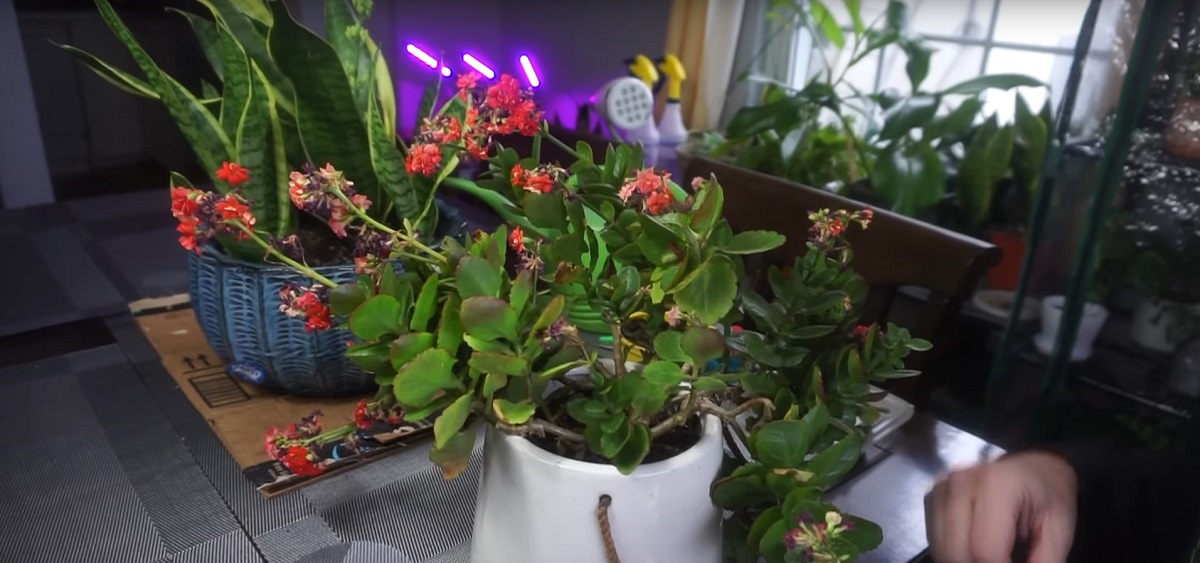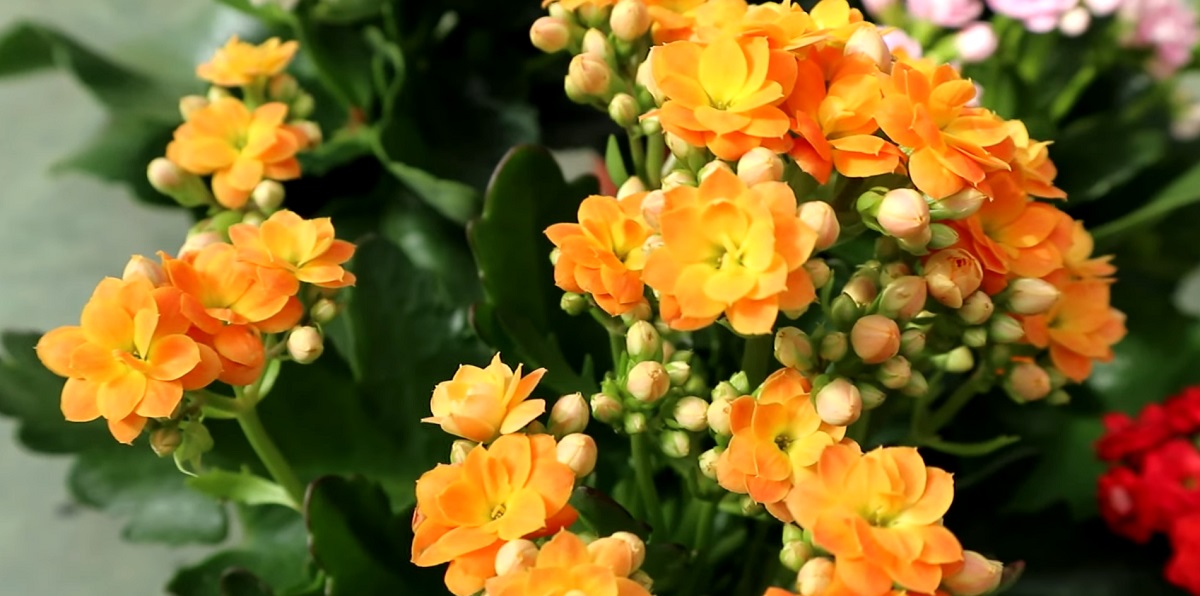Can you start Kalanchoe from cuttings?
Introduction
Kalanchoe: indoor and outdoor care
Kalanchoe is a species of plant that belongs to the Crassulaceae family. There are over 100 different species of Kalanchoe plants.
One of the most popular plants is Kalanchoe blossfeldiana, which can be easily found in plant stores, markets, and other stores.
This plant is often used indoors and for beautifying gardens. In this article, we will talk about the Kalanchoe plant and its care indoors and outdoors.
It was discovered in Madagascar by the botanist Robert Blossfeld (hence the name “blossfeldiana”). It is a perennial plant with slow growth and a long flowering period.
Its flowers usually appear with the onset of warm temperatures in spring.Kalanchoe Blossfeldiana.
The main attraction of Kalanchoe Blossfeldiana lies in its flowers, which can be in different colors such as pink, yellow, white, or orange. When it blooms, it becomes an incomparable spectacle of color.
Its fleshy, deep green leaves with serrated edges also have great appeal.
Contenidos mostrar
Kalanchoe quick guide
| Common names | kalanchoe, Kalancoe, Calanchoe, Scarlet, Mouse Ear,. |
| Scientific name | Kalanchoe blossfeldiana |
| Family | Crassulaceae |
| Irrigation | Allow to dry between waterings. |
| Lightning | Moderate sun, semi-shade. |
| Temperature | 18 – 27ºC |
| Humidity | Baja |
| Substratum | Light, well-drained soil. |
Can you start Kalanchoe from cuttings?
The way to grow more kalanchoe plants is the same as other succulents. They can be easily grown by cutting a stem or removing small sections, and these new parts usually develop roots within 15 to 20 days.
types of kalanchoe
In addition to the Kalanchoe blossfeldiana , some of the best-known and most commercialized Kalanchoe species are:
- Kalanchoe Beharensis (Elephant Ear)
- Kalanchoe Longiflora
- Kalanchoe Daigremontiana
- Low Kalanchoe
- Kalanchoe tomentose
- Kalanchoe Sexangularis / Rubinea
- Kalanchoe Lucia
- Kalanchoe pumila
- Kalanchoe Thyrsiflora
Kalanchoe care
Irrigation
Perhaps you are not quite clear on when to water your kalanchoe. First of all, you should know that this is not a plant that needs a lot of watering.
These plants can store water in their succulent leaves, so they have this reserve that helps them survive drought very well.
Remember: if you want to keep your kalanchoe alive, it is always better to under-water than over-water.
If the leaves turn yellow and fall off, it is a sign that you are watering your plant too much. Never water when the substrate is still very wet.
On the other hand, the soil must drain well to avoid waterlogging, and for this, it is essential to use pots with holes in the bottom. Keep these factors in mind when watering your kalanchoe.
If the plant is in full sun, it will need more frequent watering, depending on the season and the degree of dryness of the soil.
temperature and humidity
Kalanchoe develops well at temperatures that are more or less between 18 – 27ºC.
In winter we must be especially careful with the Kalanchoe because it does not tolerate cold at all. It may even die if the temperature drops below 10ºC. It does not tolerate frost.
Substratum
The mixture depends on whether the plant will be in the sun or indoors.
Indoors you need a lighter and better draining substrate than outdoors. If the plant is in the sun, the soil must be able to retain moisture better.
Indoors, you can use a cactus substrate mixed with 30-40% perlite.
Fertilizer
It is not necessary, but you can fertilize kalanchoe once a month during its active growth period (spring-summer) with a liquid fertilizer for cacti and succulents. Be very careful with the dosage.
Reproduction
You can grow new kalanchoe plants either from seed or by taking cuttings from an existing plant.
They can be easily propagated by sticking a new cutting into moist soil. You can also put the cuttings in water to make them take root before planting them in the ground.
Kalanchoe: frequent problems and doubts
Some problems can affect the Kalanchoe plant that needs to be considered.
Kalanchoe disease
root rot
The kalanchoe is very susceptible to root rot. As I previously mentioned, this plant has succulent leaves that store water and generally does not need regular watering.
An excessively humid and poorly drained substrate is an optimal breeding ground for the appearance of this disease.
Powdery mildew and Botrytis
Both infections develop from excessive moisture in the soil. It is best to prevent them by trying not to water the plant too much and choosing a well-drained substrate for its cultivation.
pests
Mites such as the red spider and other insects such as mealybugs or aphids can attack the Kalanchoe plant, although they are not usually very prone to pests.
Why is my kalanchoe not blooming?
The Kalanchoe blossfeldiana produces clusters of flowers easily if it is in the sun. However, Kalanchoe plants grown indoors need plenty of light to flourish.
Try placing it in a brighter area, such as a window. A small dose of fertilizer during their active growing season can also help.
On the other hand, when flowering ends, they can enter a rest period. Pruning the plant when it is done flowering can improve its growth in the future.
Dried leaves or flowers
If your kalanchoe plant becomes dry, it is most likely because it needs more water.
Yes, indeed, the plant doesn’t need much water, but that doesn’t mean we should ignore it completely. When it’s too hot, the leaves can droop.
If the flowers become dry, it is a good idea to trim them. Taking off dried flowers helps make the flowers last longer.
Is the Kalanchoe sun or shade?
The kalanchoe can thrive in both shade and full sun. Depending on the climate, it may be beneficial to locate it where it receives a few hours of mild sunlight per day.
Toxicity
The Kalanchoe blossfeldiana is a toxic plant for cats and dogs.
Conclusion
Kalanchoe needs a temperature of 60 to 85 degrees Fahrenheit to grow and survive. If you expose it to the cold, it will die.
The Kalanchoe plant needs plenty of light, but avoid direct light. Direct sunlight will burn it. These environmental parameters should be maintained until the plant is transplanted.
You should wait until the plant’s soil is dry before watering to prevent the roots from rotting.
Note: If you want to plant Kalanchoe in the garden, I must tell you that Kalanchoe is an invasive plant.
If you are not careful, it will take over the whole garden or you will have to look after it regularly or set up an exclusive place for it.
Regardless of which method you use to propagate Kalanchoe, this plant does not need much care.
You can get it to flower again. You can give an adult plant to anyone as a gift. Or you can forget to water it and it will forgive you. And it will reward you with even more flowers.











